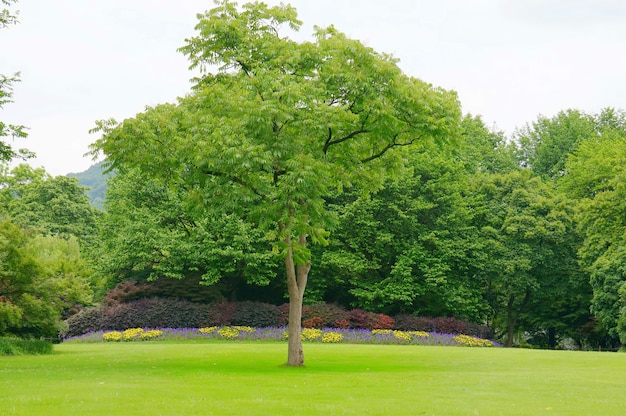
5 Ways To Choose the Right Tree For Your Garden

A well-kept yard is a white canvas filled with artfully painted trees. The outdoor retreat gains color, texture, and equilibrium because of the trees.
They act as the tasteful commas in a garden's narrative. The appropriate one is like the correct brush for a beautiful painting. This article examines five professional recommendations for selecting the ideal tree for your yard.
Temperature Compatibility
First, let's speak about the weather. Trees have comfort zones; they tend to grow only in suitable environments. A sub-tropical tree cannot bloom in arctic conditions. Therefore, your first objective is to familiarize yourself with the climate.
The hardiness zone is crucial for planting a tree in the right condition. Different regions have different hardiness zones. Hence, you need to buy trees that are appropriate to the temperature and climate of your region. For instance, if you are someone residing in the UK, you can buy trees online UK and have them delivered to your doorstep.
Size Matters
Before making a purchase, check and measure the size of your yard. Once they begin to develop, trees have no concept of boundaries. They will disperse their roots and branches everywhere. Therefore, make sure your tree has enough space.
Consider the size of your garden. Opt for smaller trees like dogwoods or ornamental cherries if you have a smaller yard. On the other hand, you can plant enormous oaks or maples if you have plenty of extra space. However, you should always consider how far your new tree companion is from buildings and electricity lines. Overgrown trees can branch out on livewires and uproot building foundations.
Flower Power

From an evergreen tree that remains green all year round to a flowering tree full of vivid, colorful tree blooms. The way your tree blooms can influence the atmosphere in your garden.
It's similar to choosing clothing. Some trees stand out in the spring when they are covered with vibrant blossoms. This group includes dogwood, cherry, and magnolia trees.
Others, like pine and spruce trees, are dependable all-season trees. They continue to exude that greenery all year long. So, it is important to determine if you prefer spring fashion or adore all four seasons and then select your tree accordingly.
Native vs. Non-Native
Adopting native trees is ideal as they have evolved to live in their local weather and circumstances. Temperature compatibility is a part of this version on account of the fact that they have evolved mechanisms to tell the tale of the temperature swings of the location.
In the face of environmental boundaries, local trees are regularly more robust and hardier. They have proved a natural capability to tolerate neighborhood pests, illnesses, and cruel climate occasions that non-native trees may additionally conflict with through medical studies and real-international observations.
Native trees have ecological ties with local fauna, including birds, bugs, and mammals. These animals depend upon them for meals and habitat. Biodiversity conservation has been proven to be important for environmental health and sustainability.
Non-native trees are unfamiliar with the local climate and vegetation. Some species can function as parasites, destroying the nearby vegetation. Animals and birds may not be able to adapt to non-native trees.
Vocal for Local

It is crucial to conserve the native trees that possess a unique allure and beauty. Preferring local vegetation will add a special touch to your surroundings, enhancing visual appeal.
Observe the local trees in your neighborhood and then make an informed decision to add a tree to your garden.
Water & Sun Availabilit
All trees require water and sun, in less or more quantity. Some trees, like rep maple and weeping willow, require a hefty amount of water that may not be a viable option. Make sure your trees have enough sun exposure. If proper sunlight can’t reach your garden, evergreen and Carpinus japonica are some options that don’t require much sunlight.
Mistakes to Avoid During Selecting Trees
Let's now discuss mistakes that should be avoided during planting trees. Introducing invasive non-local trees can damage nearby ecosystems. These species have a tendency to outcompete native flowers, disrupt nearby meal chains, or even modify the bodily structure of the environment.
Some tree species are mainly susceptible to particular diseases or pests. Planting such species without cautious attention and preventative measures can result in the fast spread of illnesses affecting the planted bushes and neighboring plants.
Trees that are not tailored to the local climate can struggle to live on, leading to wasted assets and time. Some tree species are evidently competitive in their boom conduct. Planting those species without the right management can result in overcrowding, shading out different plants, or even structural damage to buildings or infrastructure.
Conclusion
Choosing the right tree is not a hassle if the above points are kept in mind. These suggestions will help you choose the right tree that is going to elevate your garden and add a new layer to the overall layout of your yard. Be cautious of the temperature compatibility, hardiness zone, tree preferences and the species of tree. By making this choice, you will bring some of the splendor of nature and a tree to your property.
SIIT Courses and Certification
Also Online IT Certification Courses & Online Technical Certificate Programs

